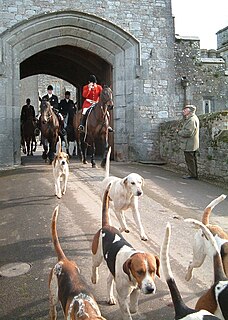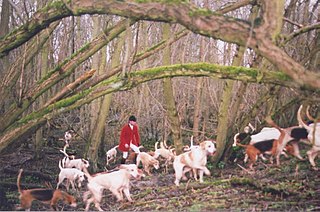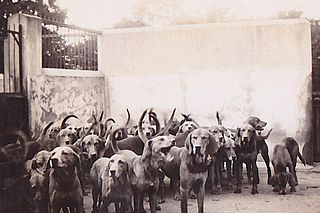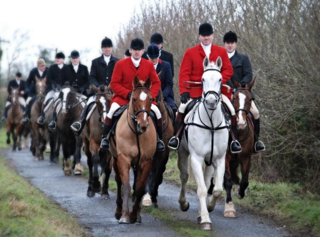 W
WFox hunting is an activity involving the tracking, chase and, if caught, the killing of a fox, traditionally a red fox, by trained foxhounds or other scent hounds. A group of unarmed followers, led by a "master of foxhounds", follow the hounds on foot or on horseback.
 W
WThe Burns Inquiry was a Government committee set up to examine the facts in the debate in the United Kingdom about hunting with hounds.
 W
WA field hunter, or a fox hunter, is a type of horse used in the hunt field for fox hunting and stag hunting.
 W
WA foxhound is a type of large hunting hound bred for strong hunting instincts, a keen sense of smell, their bark, energy, drive, and speed. In fox hunting, the foxhound's namesake, packs of foxhounds track quarry, followed—usually on horseback—by the hunters, sometimes for several miles at a stretch; moreover, foxhounds also sometimes guard sheep and houses.
 W
WHound Music by English author Rosalind Belben has been described by The Atlantic Companion to Literature as a 'fine historical novel. Published in 2001 by Chatto and Windus it is set at the beginning of the twentieth century in rural England and concerns fox-hunting.
 W
WMemoirs of a Fox-Hunting Man is a novel by Siegfried Sassoon, first published in 1928 by Faber and Faber. It won both the Hawthornden Prize and the James Tait Black Memorial Prize, being immediately recognised as a classic of English literature. In the years since its first appearance, it has regularly been a set text for British schoolchildren.
 W
WPierson v. Post is an early American legal case from the State of New York that later became a foundational case in the field of property law. Decided in 1805, the case involved an incident that took place in 1802 at an uninhabited beach near Southampton, New York. Lodowick Post, a local resident, was out with a hunting party when his hunting dogs caught the scent of a fox and began pursuing it. As they drew near the fox, Jesse Pierson, another local resident, saw the fox—though he denied seeing Post and his party—and promptly killed it and carried it off for himself. Post filed a lawsuit against Pierson claiming that because he had already begun pursuing the fox, the property of the fox's pelt and carcass were rightfully his, not Pierson's. The local justice ruled in favor of Post. Pierson appealed the ruling to the New York Supreme Court of Judicature, who reversed the justice's decision and ruled in favor of Pierson.
 W
WR (Jackson) v Attorney General [2005] UKHL 56 is a House of Lords case noted for containing obiter comments by the Judiciary acting in their official capacity suggesting that there may be limits to parliamentary sovereignty, the orthodox position being that it is unlimited in the United Kingdom.
 W
WRagdale Hall is a large hall in the Melton district of Leicestershire, England.
 W
WThe Royal Calpe Hunt of the British Crown Colony of Gibraltar originated in 1812 as the Civil Hunt. The fox hunt was initially a civilian endeavour that began when a pair of English foxhounds were imported to Gibraltar. The hunts took place across the border, in the Campo de Gibraltar area of Spain. However, in 1814, the membership of the Hunt underwent a substantial change. Many officers of the Gibraltar garrison joined the Hunt, which shifted from a civilian to a military enterprise. That year, the name was changed to the Civil Calpe Hunt. It retained that title until 1817, after which it was known as the Calpe Hunt. The first Master of the Hunt was Charles Elphinstone Fleeming. However, the Master most associated with the Hunt was Pablo Larios, Marquis of Marzales, who held that title for forty-five years. His election to that position in 1891 was not only historic, but strategic. His appointment represented only the second time that the position had not been filled by a member of the military. In addition, his Spanish heritage and influence in the Campo de Gibraltar, where he owned extensive estates, garnered him the loyalty of the local Spanish farmers, and therefore eased the ever-present tensions between the military and the farmers over the crop damage that was inherent to the Hunt. In 1906, King Edward VII of the United Kingdom and King Alfonso XIII of Spain became joint Patrons of the Hunt, after which it was known as the Royal Calpe Hunt. The tradition of the Hunt continued for more than a century, until 1939, and the onset of the Second World War
 W
WScarteen is a townland in the civil parish of Ballyscaddan, County Limerick, near the village of Knocklong. It is best known for the Scarteen Hunt, a fox hunting pack of Kerry Beagles based at Scarteen House, a big house owned since the 1750s by the Ryan family, one of the few Catholic gentry of Penal times. The dogs' coat pattern gave the hunt its nickname, the "Black and Tans", later applied derisively to the Royal Irish Constabulary Special Reserve during the Irish War of Independence. Hunt master Thady Ryan (1923–2005) increased the hunt's cachet among visitors from Great Britain and the United States and, later, Continental Europe. Ryan was chef d'equipe of the Irish eventing team at the 1964 and 1968 Olympics. As of 2016 the hunt is mastered by Thady's son Chris Ryan.
 W
WTally-ho is the traditional cry made by the huntsman to tell others the quarry has been sighted. It may also be used with directions, including "away" and "back".